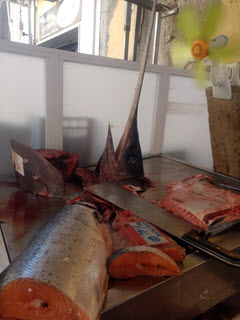
We started the day with a visit to the spectacular Mercato Ortygia, the large local farmers' and fishermans' market just a few blocks from where we stayed.
What an experience! We saw such fish! Here's a swordfish seller's counter. He'd cut the fish here, either to order or to restock the ice-covered counter in the front of the stall.
There were also two kinds of shrimp, several varieties of clams, octopus and squid, and many fin-fish including a very long silvery monster called a spatula.
There were flies, of course, but the fish was clearly fresh and well-kept. There's plenty of competition at the market.

And the produce was beautiful, with figs as big as my fist. Here is a basket of bright yellow-orange zucchini blossoms. We saw zucchini blossoms on many menus, sometimes stuffed and usually deep-fried as large fritters.
Considering how many zucchini we see in New England in the late summertime, I'm surprised that we so seldom see the blossoms.
There were also bulk spices and herbs in great bins on long colorful tables. There were several varieties of pistachios, which figure very prominently in Sicilian cuisine. Lemons and oranges and citron were everywhere, and watermelons of all sizes. There were a couple of butchers with good-looking meats, but they were vastly outnumbered by the fishmongers and produce-sellers. Of course there were plentiful salumi of many varieties. There was not a lot of baked goods and none of the soaps and other non-food items that we so often see at our farmer's markets.
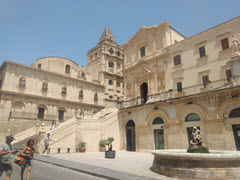
After the awesome Mercato Ortygia in the morning, we set out for the much-hyped hill-town of Noto, completely rebuilt in baroque style after a devastating earthquake. We parked in a public lot and walked down to the main street. It was a hot day, as you can imagine, inland southern Sicily in July!
Noto does indeed have some interesting architecture. It's like walking through a movie set; I expected swaggering caped bravoes and ladies with high powdered hair and parasols to step out from any corner.
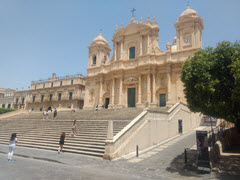
But there really wasn't that much there. The shopping was modest, with rather more t-shirts and souvenir trinkets than the high-quality pottery and leather goods typical of other Italian towns and cities that we had visited. And the sameness of the architecture was not as charming as the centuries-different mix of styles that we saw in the places that had grown over time and escaped the devastation of earthquakes. Noto reminded me somewhat of tragic Pompeii that way, frozen in time.
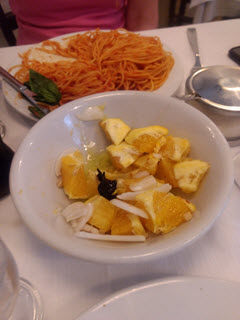
The dining was mostly uninteresting as well; the ubiquitous gelato stalls were well-attended, and we got fresh-squeezed orange juice from a pretty tattoed street-vendor's pushcart. Lorna found an acceptable Cassata alla Siciliana, but pretty much everything else was standard fare until we found the locavore and traditional Trattoria Al Buco.
We started with a light, tasty salad of peeled oranges and fennel. This was aromatic and served chilled. We suspected a fine experience, so we relaxed and ordered a bottle of local wine.
I also had a grilled local pork sausage, the delightfully named Salsiccia di Palazzolo agli aromi di campagna, or Sausage of Palazzolo with country aromas. I had to order this, both because it is a very local recipe and housemade, but also in honor of Il Salsicchaia, the sausage-seller hero of last night's play at the Greek theater.
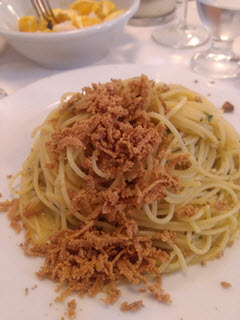
Then there were pasta dishes all around; mine was the Spaghetti alla Bottarga Tonno, spaghetti dressed with an ample portion of the grated dried tuna roe.
Bottarga is the dried roe of either mullet (the Sardinian bottarga) or tuna (the Sicilian bottarga). It's used to dress pasta somewhat like we use Romano or Parmesan cheese, to add richness and salt. You can sometimes find it at the Salumeria Italiana on Richmond Street in the North End, but it's awfully expensive. One of my culinary goals of this trip was to sample both bottargas, so I was happy to find this one, salvaging an otherwise disappointing travel experience. And now if I do buy it in Boston, I know how to serve it and what to expect.
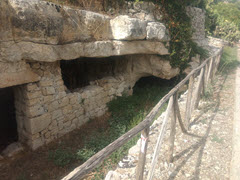
We had to make tracks, because the end of the day had to find us on the late ferry to Malta and we still wanted to see the ancient cave-dwellings and tombs of the Cava d"Ispica, the town of Modica (known for chocolate), before getting dinner in the port town of Pozzallo and catching the late ferry to Malta.
The Cava d'Ispica is an amazing series of ancient caves used as dwellings and burial places as recently as the 19th century, although today it looks more like it must have looked 3000 years ago - all traces of more recent construction is gone but for paths and fences. The view was amazing, and the path would be fun to follow, but the day was far too hot for extended outdoor excursions, so we explored for about 45 minutes and then proceeded to Modica.
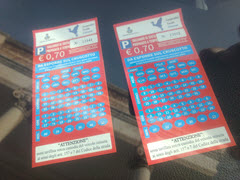
Modica was a traffic hell. It had all the old-world charm of Framingham, with the added feature of vertical roads and hairpin turns, and amazingly complicated parking.
These parking cards are each good for an hour, and each has blue bubbles for year, month, day, hour and minute. You buy a card for each hour that you need, and x-out the right combination to mark the start of your parking. If you need more than an hour, then you get a second card and mark it the same as the first - the metermaid knows you've got two hours. 0.70 Euro for an hour is not expensive for parking.

But we didn't like Modica and never found the charm that may wait there undiscovered. We bolted down to the shore and Pozzallo, enjoying Giulia's air-conditioning.
Pozzallo is a small town with large old stone fortifications along the waterfront. It's not a thriving commercial center; the ferry terminal is a little outside of town and I think most vehicle traffic bypasses Pozzallo for more important destinations in Sicily and beyond.
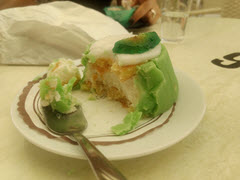
While we waited for the appointed time for the ferry, we got dinner in a seaside piazza: an excellent pizza made even more excellent by the welcome seabreeze. Another cassata accompanied by good coffee rounded out our gustatory experience for the first leg of our Sicilian experience. In the morning we would be in Malta.
